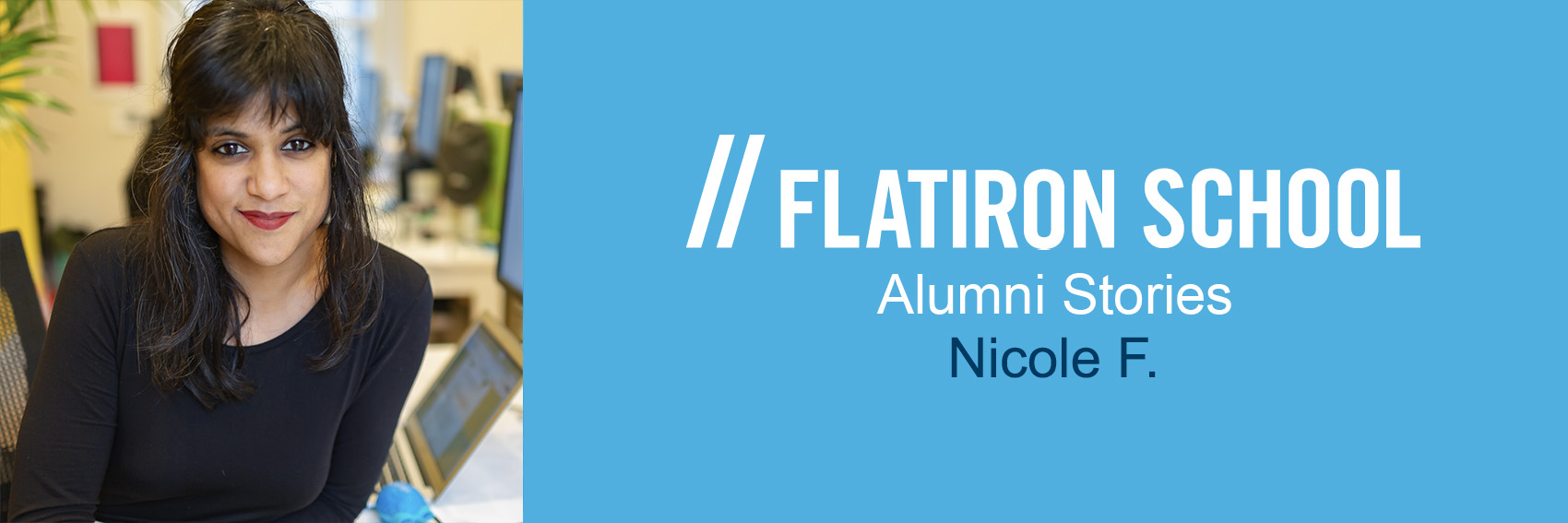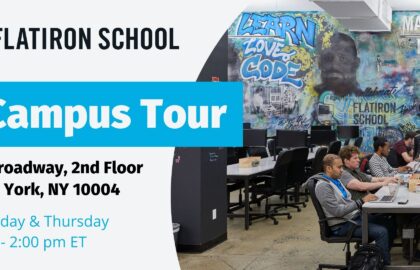Nicole F. was working in sales for a specialty coffee roastery in South London when she noticed a problem. No, the coffee wasn’t bitter. There was simply no communication between customers and experts. Those experts were also disconnected from suppliers. Seeking those connections, she decided to switch careers. She wanted to bring worlds together and found her answer in user experience (UX) design. She enrolled in Designation, the world’s largest dedicated User Interface (UI) and UX digital design program with courses in Chicago, New York, and London, and moved to Chicago from London. Nicole immersed herself in UX/UI design and was able to network with future tech colleagues. She’s now a User Experience Consultant at Fluent Interaction and has a career where she makes connections daily.
Below, Nicole discusses her journey from musician to sales to UX designer while attending Flatiron School’s Chicago campus. If you want to find a career you love, it’s all about making connections.

Around the world
Nicole has lived quite the life. She was a touring musician and played on stages around the world. Her musical journey eventually led her to a sales job. It may not have been as glamorous, but she found success. She started off working on developing new sales for a coffee roaster before becoming the Head of Coffee where she sourced coffee from around the world.She went from the stage to buying trips to Nicaragua and other coffee growing regions around the world. Her unique background let her see the bigger picture and a larger problem. “I became aware of the disconnect between customers and experts as well as between suppliers,” said Nicole. Nicole worked on solving this problem and also discovered something about herself. “I found myself trying to reconcile the many disparate worlds by improving the way we all communicated with each other,” said Nicole. “I found this facilitation to be my strength.”This realization was her catalyst to pursue a new career. It also led her to change her life and move to the United States as she pursued a design career.
Key takeaway: It’s important to find meaning in your career. Identify what excites you in a job and seek those connections. You’ll produce more meaningful work and may even find a new career along the way.
Choosing the right design bootcamp
Take it from a trained musician to tell you about the importance of practice. After learning about UX design as a potential career, Nicole started attending bootcamp open houses.The events were valuable learning experiences because it helped her see what she didn’t want to do. “I wasn’t convinced that they would be able to turn me into a fully fledged UX designer in eight weeks,” she said of one bootcamp. She was skeptical you can learn anything in eight weeks, let alone an entirely new career. “I was in sales with no tech or human-centered design experience, eight weeks is not even enough to learn how to play ‘When I Come Around’ by Green Day on guitar for some people,” said Nicole. Nicole learned about Designation from a friend who graduated a year prior. Her friend painted an honest and passionate picture of what to expect. At the time, Designation was based out of a startup incubator in Chicago. Nicole could learn new skills while networking in her new industry. Convinced, she packed her bags for the next leg of her journey.
Key takeaway: Take the time to explore your options. Determine what you need in a bootcamp. Attend events, workshops, and ask questions. This is an important decision and you need a complete picture before choosing a bootcamp.
The Designation experience
Nicole knew attending Designation would be a rigorous process. She would become a UX designer after 24 weeks, but that required hard work and some patience. She studied as much as she could before landing in Chicago.At Designation, she was welcomed by staff and her cohort. They were in this together. “Designation empowers their students with design tools and project experience. But, at no point do they make you feel that anything will be handed to you,” said Nicole. She says the people were her favorite part of Designation. Everyone had the same goal. The staff wanted the students to succeed and the cohort wanted to change their lives and become designers. Most of the staff were Designation graduates, so they understood what the students were going through and could provide practical advice. Hard work was balanced with fun moments.Learning software and UX processes on the job became a “fine art” at Designation, according to Nicole. “The open mindedness and patience required to learn Axure or Sketch or even affinity diagramming against the clock are hard skills and soft skills that I have never stopped returning to as a designer,” she said. Most importantly, she learned to believe in herself and that helped her during the interview process and in her new job at Fluent Interaction.
Life as a designer
Nicole moved back to London and accepted a role at Fluent Interaction where she gets to see the fruits of her labor almost instantly. She can create and test concepts in a matter of weeks. There’s a sense of accomplishment that makes you want to go to work each day. She’s also worked on exciting projects as a design. Nicole worked on a full website redesign for the U.K.’s National Cyber Security Centre which will go live in the near future. She wants to continue working in an agency setting to help hone her skills. Her dream job would be working for a charity as a UX designer. Her advice to prospective designers is to always network, hone soft skills, and take on challenges. She recalls how she accepted on opportunity from LinkedIn. She’s now Nicole’s mentor and has opened even more doors for her as a designer.




